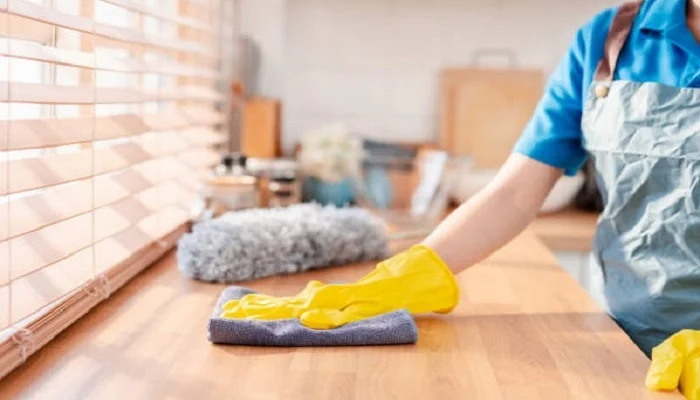Introduction to Indoor Air Quality and Health
The air people breathe at home can significantly affect well-being, health, and day-to-day comfort. In fact, according to the Environmental Protection Agency, indoor air is often more polluted than outdoor air, making indoor air quality a critical issue for anyone concerned about their respiratory health. Modern homes are built to be energy efficient, but the same sealed environments designed to conserve energy tend to trap pollutants and allergens inside. Without active efforts to keep these contaminants in check, their concentration increases over time, quietly impacting the health of adults, children, and pets. To help manage these challenges, many rely on weekly house cleaning services to ensure consistent air quality and support healthier living.
Poor indoor air quality has been linked to symptoms like frequent headaches, fatigue, and worsened allergy or asthma flare-ups. For sensitive people such as children or older adults, the influence of dirty indoor air is even more pronounced, leading to infections or chronic irritation. Most pollutants are invisible, and their presence can go unnoticed until someone in the home starts feeling the effects. Given how much time is spent indoors, it’s no surprise that many households seek strategies to improve their air, from smart ventilation to healthier cleaning routines. Among these, embracing regular weekly house cleaning services is a proven way to keep air clean and make living spaces healthier without adding stress to busy lives.
Primary Contributors to Poor Indoor Air Quality
The contributors to degraded air quality are numerous and often subtle. Dust and dander from everyday living, pollen drifting in from outside, and flaky skin cells shed by people and pets all build up within a few days. Beyond these are the more insidious airborne contaminants: volatile organic compounds (VOCs) released from air fresheners, paints, cleaning supplies, and new furniture; and mold spores that thrive in damp corners or bathrooms. VOCs and mold are hazardous—long-term exposure can cause headaches, dizziness, trouble sleeping, and even long-term respiratory conditions.
The Centers for Disease Control and Prevention identifies poor air circulation as a compounding factor, especially in homes with clogged air filters, closed windows, or inadequate exhaust in kitchens and bathrooms. This allows humidity and particles in the air to settle on fabrics, carpets, and walls. With each movement—walking, sitting on furniture, or opening drapes—these particles are disturbed and recirculate, making it especially difficult for those with sensitivities to catch a break. The result is a sometimes-invisible but constant churn of irritants that can affect everyone in the house.
In addition to routine household sources, seasonal factors play a role. Spring and fall usher in pollen, while summer’s humidity escalates the risk of mold. In the winter, houses are usually shut tight, causing dust and dander to accumulate. The simple action of not removing shoes at the door or neglecting soft surfaces like drapes and upholstery magnifies the load of microscopic debris in the home. These patterns explain why indoor air problems are common year-round, not just during certain months.
The Role of Weekly Cleaning in Allergen and Dust Control
Keeping ahead of dust and allergens requires a routine, not a once-a-year effort. Weekly cleaning addresses problems before they become overwhelming, leading to consistently fresher air and easier breathing. Thorough vacuuming—especially with HEPA-filter machines—removes fine particulates that would otherwise be kicked up and inhaled. Similarly, washing bedding, curtains, and pillow covers on a predictable schedule limits dust mite populations and the spread of pollen or pet dander.
Weekly dusting is crucial, as dust rapidly collects on shelves, electronics, baseboards, and window sills. A damp or electrostatic cloth captures particles rather than just moving them around. Families that incorporate these habits often notice decreased sneezing, coughing, or stuffed-up noses. This is even more essential for homes with children, pets, or individuals prone to allergies and asthma.
In addition to visible improvements, regular routines mean homes feel lighter. Air smells crisper, rooms appear more inviting, and allergy medications may not be needed as frequently. The benefit extends to guests, too—no embarrassing dust, no pet hair lurking on the sofa, and no musty odors. Over time, these practices set a standard where dust, dander, and other irritants never get out of control.
Managing Mold, Bacteria, and Viruses Through Consistency
The main thing that mold and bacteria like is wet places. Bathrooms, kitchens, laundry rooms, and basements naturally collect humidity, and if not cleaned and dried frequently, they provide a perfect environment for unhealthy microbial growth. Mold spores cause musty odors and can be dangerous for those with asthma or compromised immune systems, and even healthy people may develop sensitivities over time.
Weekly scrubbing of showers, tile grout, and sinks eliminates the buildup of soap scum and residues where bacteria thrive. Regularly changing bath mats, towels, and shower curtains reduces the risk of mold taking root. Disinfecting touch points like door handles, light switches, and remote controls helps keep viruses and bacteria from spreading among family members—this has been especially important since research began linking routine surface cleaning to fewer incidents of colds and flu.
Focusing on small details, such as cleaning behind toilets or under sinks and checking for leaks or pooled water, helps prevent moisture and microbial issues from growing. Weekly attention means problems are caught early, when they’re easy to manage, rather than spiraling into a larger health hazard later.
The Impact of Cleaning Methods and Products on Air Quality
Not all cleaning approaches are created equal. Depending on their ingredients and how they’re used, products and practices can improve indoor air. Harsh, fragranced chemicals or sprays may provide short-term shine but can leave behind irritants that linger in the air, sometimes causing throat irritation or headaches. These products may do more harm than good for families with young kids, pets, or allergies.
Best practices now favor plant-based cleaners, unscented formulas, and natural options like vinegar and baking soda. Microfiber cloths and damp mops trap dust better, reducing particles kicked up during cleaning. Ensuring good ventilation during and after chores—by opening a window or running an exhaust fan—helps clear the air too. This approach, combined with frequent cleaning, means contaminants are regularly removed instead of just masked or temporarily dispersed.
Another key factor is the proper use and storage of cleaning products. Leaving containers open or using excessive product in closed spaces can increase air concentrations of VOCs. By measuring out cleaners, diluting where needed, and always following label instructions, it’s possible to maximize cleaning power while minimizing health risks. Over time, these habits protect sensitive individuals and contribute to a longer-lasting, fresher-smelling home.
Benefits of Weekly Cleaning Services Over Occasional Deep Cleaning
Although a thorough deep clean is important a few times a year, regular weekly cleaning truly keeps indoor air at its healthiest. Dust, mold spores, and airborne contaminants build up quickly—sometimes within days or even hours—so waiting months between cleanings can allow hidden irritants to multiply. Weekly service catches dirt and allergens early, making each session shorter, less stressful, and more manageable for homeowners.
Professional cleaning teams are trained to spot and address problem zones: behind appliances, rarely cleaned window sills, and underneath beds and couches. They bring high-quality equipment—like HEPA-filter vacuums and electrostatic dusters—that are more effective than standard household models. Every corner and crevice gets attention, reducing places where particles can hide or build up. The result is a cleaner environment every week, month, and season.
Another plus of scheduled weekly cleaning is that it removes the burden from homeowners, freeing up time for relaxation, hobbies, or family. It also means there’s no need for chaotic deep cleans before hosting guests, celebrating holidays, or facing surprise visits—homes always feel company-ready. Over time, consistent professional care can prolong the life of surfaces, carpets, and fixtures, adding value and comfort for residents.
What to Expect from a Weekly House Cleaning Service
A typical weekly cleaning service includes a predictable checklist: vacuuming all floors and carpets, mopping tiles and hardwoods, dusting all surfaces, scrubbing sinks and counters, and sanitizing high-touch points like doorknobs and light switches. Laundry, changing bed linens, and periodic cleaning of less-obvious spots—such as ceiling fans, air vents, and behind furniture—may also be offered. This comprehensive approach targets visible mess and less obvious threats to indoor air and comfort.
With repeated visits, cleaning professionals get to know the home’s unique needs, priorities, and sensitivities. Families with allergies or environmental concerns can request hypoallergenic products or focus on pet trouble spots. Small requests and customizations add up, enhancing the benefits week after week. Reliable scheduling means homeowners don’t have to devote weekends or evenings to cleaning; instead, they enjoy continually fresh air and inviting surroundings.
Tips for Sustaining a Healthier Home Between Cleanings
You don’t have to wait for the next service to impact air quality. Removing shoes at the door prevents dirt, pollen, and outdoor chemicals from accumulating. Airing out the home for short intervals when outdoor air quality is good helps dilute indoor pollutants. Portable air purifiers with HEPA filters add another layer of protection, especially in bedrooms or play areas. Regularly changing HVAC filters ensures your heating or cooling system isn’t simply circulating dust.
Quick daily habits keep things on track: promptly cleaning up spills, wiping pet paws after walks, and keeping clutter to a minimum so fewer surfaces collect dust. Washing pet bedding, toys, and food dishes weekly reduces odors and bacteria. Adding a few easy-maintenance houseplants can help absorb toxins, but be careful about overwatering, which may encourage mold. These small changes support the cleaner baseline created by professional help, making every breath at home noticeably fresher.
How Consistent Cleaning Elevates Everyday Life
The effects of good air quality are immediate and long-lasting. Residents report better concentration, brighter moods, deeper sleep, and fewer headaches or allergy symptoms. Sensitive family members—children, elders, and those with medical conditions—benefit the most, but everyone enjoys the intangible uplift of a home that smells and feels clean. Guests arrive in inviting, fresh surroundings, and children and pets are safer as they play in dust-free corners and atop sanitized floors.
Over time, the benefits multiply: surfaces stay newer, less money is spent on air fresheners, and less time is lost to sick days or fatigue. Consistent routines reduce anxiety, as you no longer worry about surprise messes or intensive cleaning projects before holidays and events. Partnering with a trusted weekly house cleaning services provider offers peace of mind, creating an environment built not just for living, but for thriving. A healthier home means you can truly enjoy your own space, every single day.
Drain Cleaning Business: Clearing the Path to a Healthy Home









Comments